Only four nations across the world host the premier tournaments in tennis, which are more popularly known as Grand Slam tournaments: Australia, France, Great Britain and the United States of America.Of the four, two nations have been most dominant on the tennis landscape, America and Australia. Billie Jean King, Chris Evert, Jimmy Connors, John McEnroe and Pete Sampras are among the few stalwarts from America while Rod Laver, Ken Rosewall, Margaret Court enriched the sporting history of Australia.However, there have been many other stalwarts from the four nations, who although managed to ascend to the summit of the rankings, failed to taste success in their home arenas, much to the disappointment of the ‘home’ crowd.Let us now take a look at five former World Number ones, who were unable to win Grand Slam tournaments on their home turf.
#1 Lleyton Hewitt (Australia)
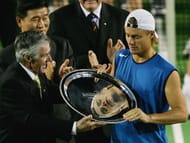
Tennis has seldom seen as tenacious a fighter as Lleyton Hewitt. So impassioned is he about the game and so determined is he in his pursuit of victory, that the energy that he exudes in the course of a match is almost palpable. Unlike some of his more flamboyant contemporaries such as Andy Roddick and Marat Safin, Hewitt’s game would never serve as a delight for those who indulged in the exercise of watching sport for a more aesthetic experience. However, even Hewitt’s most vociferous detractor wouldn’t deny the fact that Hewitt’s perseverance and resolve produced some of the most exciting tennis contests in the early years of the 21st century.
In 2001, Hewitt won his first Grand Slam title, beating Yevgeny Kafelnikov in the semi-final before besting Pete Sampras in four sets in the summit clash. He also went on to win the year-end Masters at Tokyo, defeating Sebastian Grosjean in the final, to ascend to the World Number one ranking, becoming the youngest player ever to achieve the distinction.
2002 Wimbledon saw seven of the top 10 seeds being knocked out before the fourth round. Sampras, Andre Agassi, Roger Federer and Kafelnikov were among the casualties at an event that was largely dominated by baseliners. Along with Tim Henman, Hewitt was the only other top 10 seed to progress beyond the third round.
Hewitt went all the way, beating David Nalbandian in straight sets to pocket his second and what remains his last Grand Slam title. The win further consolidated his hold on the top ranking. However, he failed in his bid to defend the Wimbledon title in ’03, falling to Ivo Karlovic in the first round.
However, Hewitt will be haunted most by his failure to win the Grand Slam in his own backyard, the Australian Open. He came mighty close to winning the trophy at the Rod Laver Arena in 2005, when he made it to the finals. Playing Marat Safin, Hewitt took the first set with ease but squandered the lead as the Russian managed to wrap up the match in four sets.
#2 Jim Courier (United States of America)
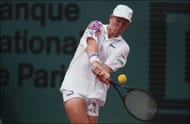
Along with Andre Agassi and Pete Sampras, Jim courier ushered in a decade of American domination in men’s tennis. Although his accomplishments pale in comparison to those of Sampras and Agassi, Courier was counted amongst the best players in the 1990s and was certainly one of the most consistent players of that era.
Courier won his first Grand Slam at Roland Garros in 1991, becoming only the second American after Michael Chang to achieve the distinction. He followed up his triumph at the French Opn by winning the Australian Open in 1992 and shortly following his win at the Rod Laver Arena, ascended to the World Number one ranking, a position he would hold for a total of 58 weeks, albeit discontinuously.
He successfully defended the French Open and Australian Open titles in ’92 and ’93 respectively. However, he failed to taste victory at both Wimbledon and the US Open, despite making it to the finals of both events.
He came undone against Stefan Edberg at the US Open in 1991, in a lop-sided affair that saw the Swede handing Courier a bagel in the third set.
#3 Amelie Mauresmo (France)
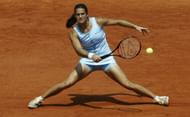
One of the most elegant and correct players ever to have graced the tennis court, Amelie Mauresmo ascended to the summit of the WTA rankings nearly 18 months prior to winning her maiden Grand Slam.
It would have been nothing short of a travesty had Mauresmo retired without a single Grand Slam to her name, for she clearly was one of the finest players that women’s tennis had ever seen. With a beautiful single-handed backhand that she played with unparalleled flourish and flair, watching Mauresmo play was a sheer delight for the senses.
The only other player whose elegance rivalled that of Mauresmo’s was Justine Henin, who was also the former’s fiercest rival.
Mauresmo tasted success at a Grand Slam event for the first time at the Australian Open in 2006, after Henin retired from the match with a bout of gastroenteritis. However, Mauresmo had taken the first set with considerable ease, 6-1 and was leading the second 2-0, before Henin retired.
Her second triumph at a Grand Slam event came six months following her success at the Australian Open. Yet again, she faced Henin across the net and this time around, her win was fair and square. In one of the most exciting Wimbledon finals in recent times, Mauresmo was stretched to three sets, after she dropped the first set before rallying to win the match 2-6, 6-3, 6-4.
It is indeed ironic that, Mauresmo, hailing from France, the country which holds the only Grand Slam event on clay, was among the best players at the net. Although she boasted a wide repertoire of strokes from the baseline, her game clearly suited the fast courts at Wimbledon than the Parisian dust.
At the French Open, Mauresmo never made it past the quarter-finals, which she reached on two occasions.
#4 Jennifer Capriati (United States of America)
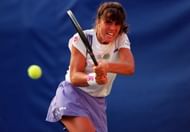
Considered to be one of the pioneers of ‘Power Tennis’ in the women’s circuit, Jennifer Capriati was famed for her ability to strike the ball hard and for her uncanny ability to stand up to some of the fastest servers in the game.
Capriati, despite turning professional at the age of 13 in 1990, had to endure a long wait for her first Grand Slam, which she won in 2001 at the Australian Open. Seeded 12, Capriati shocked the then World Number one Martina Hingis in straight sets. Later that year, she beat Kim Clijsters in an epic French Open final, in which the last set stretched out to 22 games.
She also went on to reach the semi-finals at Wimbledon and US Open and her consistency was rewarded when she ascended to the top of the WTA rankings in September that year.
Incidentally, at both tournaments, she never made it beyond the final four. In fact, she finished as a semi-finalist at the US Open on four occasions: 1991, 2001, ’03 and ’04.
#5 Patrick Rafter (Australia)
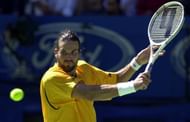
One of the finest grass-courtiers of his generation, Patrick Rafter was a two-time Wimbledon finalist, losing to Pete Sampras in 2000 and to Goran Ivanisevic the following year. Although he failed in his bid to win the most coveted prize in Tennis, Rafter swarmed into the hearts of the Wimbledon crowd, with some dazzling play at the net.
Rafter was a two-time US Open champion, winning the event in successive years, in 1997 and ’98. He climbed to the top of the World Rankings in June 1999, following highly productive seasons in 1998 and ’99. Sadly, however, he could hold onto the ranking for no longer than a week, as he was dislodged by Pete Sampras.
His record at the Australian Open, his home Grand Slam, however, isn’t too impressive. He made it to the semi-finals of the event in 2001 only to lose to eventual champion Andre Agassi in a closely fought five-setter.
#6 Honourable mention: Pat Cash (Australian Open)
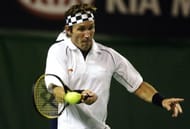
Although he never reached the coveted World Number one ranking, there is no denying the fact that his peers saw him as one of the best players.
Pat Cash won only a single Grand Slam in a career that was constantly dogged by injuries. He beat then World Number one Ivan Lendl in the final of 1987 Wimbledon to take the coveted prize.
At the Australian Open, he played two marathon finals in the years 1987 and ’88, the first against Stefan Edberg and the second against Mats Wilander, but failed to get his hands around the trophy. The 1987 Australian Open final against Edberg was the last match of that Grand Slam to be played on grass and Cash lost the nail-biting contest 3-6, 4-6, 6-3, 7-5, 3-6.
The 1988 Australian Open, played on hard courts, witnessed one of the greatest tennis matches ever played. The final between Wilander and Cash lasted four and a half hours with the last set being stretching to 14 games. Wilander prevailed to win the first of his three Grand Slams in 1988 and Cash was denied the honour of winning a Grand Slam in front of his home crowd.
